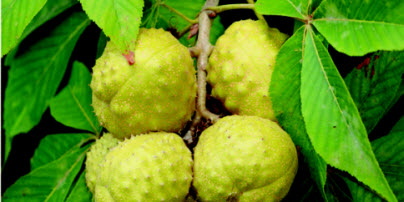If you’re looking for a fabulous tree to add to your private forest in Manitoba, consider Ohio buckeye (Aesculus glabra).
Although a member of the horse chestnut family, it is not a true chestnut. This lovely tree will grow 30 to 50 feet tall (taller in the more temperate parts of the country). It is nicely formed, with a dome-shaped crown and large (four- to six-inch-long) palmate, compound leaves (five to seven) with serrated edges. Its crown width at maturity has a 20- to 35-foot spread. One of the first trees to leaf out in spring, its fall colour is orange to red. It grows well in shade.
The bark is smooth and cool gray when the tree is young, but over time it develops thick, ashy gray, furrowed plates on its two- to three-foot-diameter mature trunk. Maturity takes 60 to 80 years to reach. The tree does not begin to produce seeds, which ripen in September to October, until it is eight years old. In its natural state, it is often found growing with bur oak, American elm, sugar maple, beech and American basswood.
Ohio buckeye is the state flower of Ohio (Canada zone 4), where it occurs naturally, but it can be successfully grown in Manitoba’s zone 3 conditions, if you plant it away from north or northwest winter winds.
It likes a damp site in rich, fertile but alkaline soil. When planting, dig a big, wide hole and amend the soil you removed from the ground to dig the hole with a bit of organic material such as leaf mould or compost. The reward will be a glorious show of pale white to greenish-yellow, four- to six-inch clusters of flowers that stand up on the branches like candles on a Christmas tree.
The flowers are followed by two-inch seed capsules or “nuts” in a spiny, although not sharp, casing. Native Americans thought the glossy, chestnut brown nuts, which have circular tawny markings, resembled the eyes of the male deer and so the name buckeye was given to the tree. The specific epithet, Aesculus, was given to the tree for the Aesculapius (or Asclepius), the Greco-Roman god of medicine.
In times past, buckeye nuts were considered a good luck charm and were used (cooked and made into a paste) to relieve arthritic and rheumatic pain. Early settlers also mashed the nuts into a meal to supplement their diets when other supplies were low, but if you’re thinking of doing this, be sure that the meat is thoroughly cooked. The nuts, leaves and bark are poisonous in their raw state. Ingestion can cause muscle weakness, paralysis, stomach cramps, vomiting and even death in most animals. Squirrels are an exception.
These negatives aside, Ohio buckeye is a lovely tree that would grace any garden. The flowers are spectacular and will steal the show away from ornamental crabs, plums or cherries. Prune it in early spring before it leafs out.



